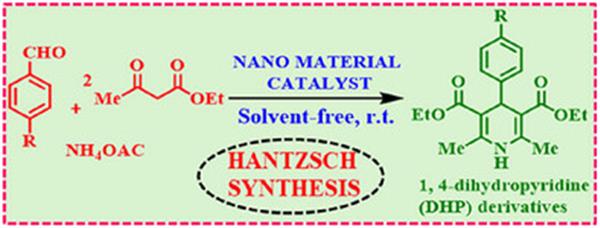Recent Advances in the Synthesis of Dihydropyridine and Their Corresponding Fused Systems via Multi‐Component Hantzsch Reaction Using Catalytic Nanomaterials
作者:Gnanamani L, Shareefa bee A, Madhu S, Venkatesan K, Annamalai P, Jianli W, Mohamad Ali
关键字:1,4-Dihydropyridine,Hantzsch synthesis , Multicomponent reaction,Nanocatalysts,Sustainable chemistry
论文来源:期刊
具体来源:ChemistrySelect
发表时间:2024年
1,4-二氢吡啶(1,4-DHPs) 是一类结构多样的吡啶衍生有机化合物,因其广泛的合成应用价值和显著的药物相关性而备受关注。经典的 Hantzsch 二氢吡啶合成法仍是构建此类杂环骨架的核心方法。近期创新技术彻底革新了 Hantzsch 二氢吡啶及其结构类似物的合成方案。本综述系统评述了 1,4-DHPs、1,8-二氧十氢吖啶(AD)和多氢喹啉(PHQ)合成领域的前沿进展,重点探讨了以醛类、β-酮酯和铵盐为前体的新兴多组分反应(MCR)策略。
特别值得注意的是,本文着重介绍了基于先进纳米催化体系的突破性进展,包括磁性纳米杂化材料、纳米结构复合材料、过渡金属氧化物、表面工程纳米粒子及生态兼容型纳米生物材料。纳米催化剂的策略性应用展现出增强的结构精确性与催化性能,标志着向可持续合成化学的范式转变。通过对纳米催化剂介导的合成路径进行批判性分析,本研究阐明了其在优化 1,4-DHPs 合成反应动力学、区域选择性和整体工艺效率中的机制作用。文中提出的发现为采用定制纳米催化剂的下一代 Hantzsch 反应工程奠定了基础,有望为 1,4-DHP 衍生药效团的绿色合成开辟新途径。
1,4-Dihydropyridines (1,4-DHPs) represent a versatile class oforganic compounds derived from pyridines, recognized fortheir extensive synthetic applications and significant medi-cal significances. Among the various synthetic methodologiesavailable, the Hantzsch dihydropyridine synthesis is particularlynotable as it provides a reliable approach to the produc-tion of these compounds. Recent advancements have markedlyimproved the synthetic pathways leading to Hantzsch dihy-dropyridines and their derivatives. This review aims to thor-oughly examine the recent progress in the synthesis of 1,4-DHPs, 1,8-dioxodecahydroacridines (AD), and polyhydroquino-lines (PHQ). Emphasis is placed on novel synthetic strategiesreported in recent years, specifically those that employ mul-ticomponent reactions involving aldehydes, β-ketoesters, andammonium salts. Furthermore, these reactions are catalyzedby various nanocatalysts, including magnetic nanoparticles,nanocomposites, metal oxides, functionalized nanoparticles, andother environmentally friendly nanobiomaterials. The applica-tion of nanocatalysts in these processes is underscored by theircontributions to structural integrity and activity enhancement,indicative of a paradigm shifts towards more sustainable andefficient synthetic methodologies. This review consolidates andassesses various synthetic routes facilitated by nanocatalystswhile elucidating their distinct roles in improving the efficiencyand selectivity of 1,4-DHP synthesis. Hence, this review may pavethe way for advancements in Hantzsch reactions by employingnanomaterial catalysts for the sustainable production of 1,4-DHP derivatives.
